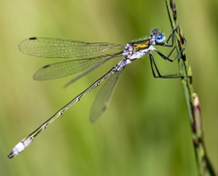Written by Samantha Walter-Cano, Edited by Olivia Zugay

If you are reading this, that means my task for the summer is over. What task, you may ask? Collecting insects that is! That’s right, I had to collect and pin insects this summer. With over 40 insects of 14 different orders, this was no simple feat. Finding 40 insects may be difficult, but as you can imagine, doing the catching is even harder. I found myself in this position when I decided to minor in entomology and take the required classes over the summer. While I was highly unsure about this project in the beginning, it proved to be one of the coolest things I’ve had to do for a grade. Learning about these creatures you share your backyard with (or even home occasionally) opened my eyes to the world of these little guys around me. I’ve started to appreciate these creatures rather than seeing them as freaky bugs that just want to terrorize you (I’m not talking about you cockroaches).
To begin, creating an insect collection can be done just by staying in the comfort of your yard. However, if you are like me and trying to find specific insects, you may find yourself in all sorts of places, such as lakes, trails, lagoons, and fields at night. However, it is fair to say that most of the insects I have collected have found me. For example, hearing a scream from the kitchen only to find that your sister was having a face-off with a Mydas Fly. While these insects are quite harmless, they are pretty scary looking. After taking my course, I would come to find that these flies mimic wasps to protect themselves from predators! These flies mimic wasps so well that it is sometimes very difficult to differentiate between them. Some common differences are in the eyes as well as the wings. Flies are the only insects with one set of wings. So, if you are unsure whether what you’re looking at is a fly or wasp (or bee), look at the wings.

Another cool experience during this project was catching insects I thought were one thing but came to find out was a whole different order of insects. As said above, this may happen with flies and wasps, but it can also happen with other orders of insects if you are not careful. For example, there was an insect collected that I was sure was a damselfly. However, while pinning it under the Odonata order with the damselflies and dragonflies, I started to realize some features of this insect were different. That’s when I pulled out my Peterson Insect Field Guide only to find out that this insect was, in fact, not a damselfly. It was an Antlion from the order Neuroptera! If you search for this insect, you can understand why these insects could be mistaken for a damselfly. Some key differences between an antlion and a damselfly are the antennas as well as the wings.
Antlions are net-winged and can fold their wings over their backs, while damselflies cannot. Antlions also have visible clubbed antennas, while damselflies do not. There are two main ways of collecting, active and passive collecting. Active collecting consists of searching for and collecting the insects, while passive collecting consists of setting a trap or bait for insects. Some different kinds of passive collecting methods include pitfall traps and light traps. A few methods of active collecting include sweep netting and debarking. I would say that I collected most of my insects actively, although the Florida porch light did attract many awesome insects!

While pinning insects can be very tedious, it is incredible to see the work you have accomplished afterward. I’ve learned that the most important thing to do when collecting insects is to give yourself time, especially when you have a hard deadline. Tools are also incredibly important, and some of the main items are a spreading board, pinning block, forceps, and pins. When collecting, it is vital to conserve the ecosystem and habitat of these insects and be mindful of the population. If you or anyone you know is interested in collecting insects, I have attached my final insect collection for reference! For help identifying insects, come visit the Indian River County Extension office!
References
https://edis.ifas.ufl.edu/publication/IN759
https://entnemdept.ufl.edu/bug_club/index.shtml
https://thedragonflywoman.com/2010/03/11/damselsvsantlions/
 2
2
